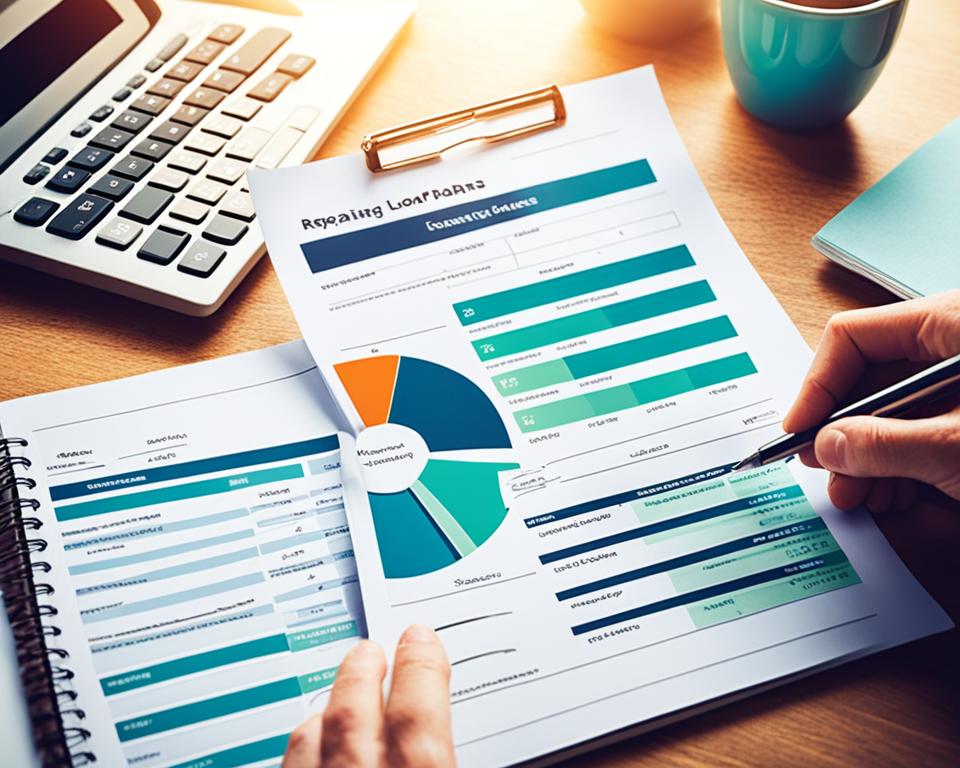Understanding loan interest rates and how they are calculated is crucial when borrowing money. Whether you’re applying for a personal loan, getting a mortgage, or considering an auto loan, knowing the ins and outs of interest can help you make informed financial decisions.
When it comes to loans, lenders charge interest to earn money on the amount borrowed. There are two types of interest: simple and compound. Simple interest is typically associated with short-term loans, such as payday loans and personal loans, while compound interest is more common in mortgages and some auto loans.
With simple interest loans, your monthly payments remain the same throughout the loan term. However, the interest you pay each month is calculated based on the outstanding principal balance. On the other hand, with compound interest loans, your monthly payments stay the same, but the portion that goes towards interest fluctuates as you repay the loan.
Key Takeaways:
- Loan interest can be calculated using simple or compound interest methods.
- Simple interest loans have fixed payments, but the interest is based on the outstanding principal balance.
- Compound interest loans have fixed payments, but the interest fluctuates throughout repayment.
- Simple interest loans are beneficial to borrowers making on-time or early payments.
- Amortizing loans, with compound interest, primarily benefit lenders over a longer repayment period.
How to calculate simple interest on a loan
Calculating loan interest is a crucial step in understanding how much you will be paying over the life of your loan. If your lender uses the simple interest method, you can easily calculate the interest by following a simple formula:
Simple Interest = Principal Loan Amount x Interest Rate x Loan Term
Let’s say you take out a five-year loan for $20,000 with a 5% interest rate. To calculate the simple interest, you would use the formula:
Simple Interest = $20,000 x 0.05 x 5
Simplifying the equation gives us:
Simple Interest = $5,000
So, in this example, you would pay $5,000 in interest over the five-year term of the loan.
Why is this calculation important?
Knowing how to calculate simple interest on a loan empowers you to understand the true cost of borrowing. It helps you evaluate the affordability of the loan and make informed financial decisions. By considering the principal loan amount, interest rate, and loan term, you can anticipate and plan for the total amount you will repay.
Now that you know how to calculate simple interest, you can confidently proceed to analyze the benefits and drawbacks of simple interest loans. Understanding the calculations behind loan interest puts you in control of your financial future.
Who benefits from simple interest
When it comes to loans, borrowers who make on-time or early payments are the ones who reap the benefits of simple interest. This type of interest calculation is a favorable choice for borrowers because it is based solely on the loan principal, offering potential savings compared to loans with compound interest.
Simple interest can be found in various types of loans, particularly in short-term loans such as payday loans and car title loans. Additionally, some personal loans, vehicle loans, and even mortgages may also utilize simple interest.
By understanding how simple interest works and making prompt payments, borrowers can take advantage of this straightforward interest calculation method.
How to calculate amortizing interest on a loan
Calculating the interest on an amortizing loan involves a step-by-step process. With amortizing loans, such as mortgages and some auto loans, the interest calculations change over time. Here’s how to calculate amortized interest:
- Divide the interest rate by the number of payments per year.
- Multiply the result by the remaining loan balance to determine the monthly interest amount.
- Subtract the monthly interest from the fixed monthly payment to find the principal payment.
- Repeat the process with the new remaining loan balance for each subsequent month.
This calculation method ensures that you’re gradually paying off both the principal loan balance and the accrued interest over the loan term.
By following this process, borrowers can gain a better understanding of how their monthly payments are distributed between principal and interest, allowing them to track their progress in paying down the loan.
Who benefits from amortized interest
Amortized interest, commonly used in personal loans, mortgages, auto loans, debt consolidation loans, home equity loans, and student loans, primarily benefits lenders. As amortizing loans progress, a larger portion of each monthly payment goes toward the principal loan balance, allowing the lender to recoup their investment over time.
Unlike simple interest loans where the interest remains constant throughout the loan term, amortizing loans have fixed monthly payments that consist of both principal and interest. This structure ensures that the loan is paid off in full by the end of the term.
Let’s take a closer look at how amortized interest benefits lenders:
1. Consistent Cash Flow
With amortized interest loans, lenders receive a consistent stream of principal and interest payments over a specified period. This allows them to plan their finances and allocate resources effectively. The regular monthly payments contribute to a stable cash flow for lenders, reducing the risk of financial instability.
2. Lower Risk and Increased Return
As borrowers make their monthly payments, a portion of each payment goes towards reducing the principal balance. This gradual reduction in outstanding debt minimizes the risk for lenders. Additionally, lenders earn interest on the remaining principal balance, ensuring a reliable return on their investment.
3. Structured Repayment
Amortized interest loans have a predetermined repayment schedule, providing lenders with predictability and clarity. Each payment is meticulously calculated to ensure that the loan is fully repaid, allowing lenders to accurately track the progress of the loan and manage their lending portfolio more effectively.
| Benefits of Amortized Interest for Lenders | Description |
|---|---|
| 1. Consistent Cash Flow | Lenders receive regular principal and interest payments, ensuring a stable cash flow. |
| 2. Lower Risk and Increased Return | Gradual reduction in the principal balance minimizes risk for lenders and ensures a reliable return on investment. |
| 3. Structured Repayment | Predetermined repayment schedule allows lenders to track loan progress and manage portfolios effectively. |
By offering amortized interest loans, lenders create attractive borrowing options for individuals and businesses, facilitating long-term financial stability and growth. It’s essential for borrowers to understand the benefits and implications of amortized interest when considering loan options.

As we’ve explored how amortized interest benefits lenders, the next section will discuss the factors that can affect how much interest you pay on a loan.
Factors that can affect how much interest you pay
When it comes to borrowing money, several factors play a role in determining how much interest you’ll have to pay back. Understanding these factors can help you make informed decisions and potentially save money in the long run.
The first factor to consider is the loan amount. Generally, the higher the loan amount, the greater the risk for the lender. As a result, lenders may charge higher interest rates for larger loan amounts to compensate for the increased risk.
Your credit score also plays a significant role in determining the interest rate you’ll be offered. A higher credit score indicates a lower risk for the lender, which may result in lower interest rates. On the other hand, a lower credit score could lead to higher interest rates as lenders perceive the borrower to be at a higher risk.
The loan term is another factor that can affect the interest you pay. Generally, loans with shorter terms tend to have lower interest rates. However, it’s important to note that shorter loan terms also mean higher monthly payments. On the other hand, loans with longer terms may have higher interest rates but lower monthly payments.
The repayment schedule is closely tied to the loan term. Different repayment schedules, such as monthly, bi-weekly, or quarterly payments, can affect the interest you pay over the life of the loan. Some lenders offer discounted interest rates for borrowers who opt for certain repayment schedules.
Pro Tip: Before taking out a loan, consider all these factors and assess your financial situation. It’s wise to shop around and compare offers from different lenders to find the best interest rate based on your circumstances.
Factors Affecting Interest Rates:
| Factor | Explanation |
|---|---|
| Loan Amount | The higher the loan amount, the greater the risk for the lender, potentially resulting in higher interest rates. |
| Credit Score | A higher credit score may lead to lower interest rates, while a lower credit score may result in higher interest rates. |
| Loan Term | Shorter loan terms typically have lower interest rates, while longer loan terms may have higher interest rates. |
| Repayment Schedule | Different repayment schedules may impact the interest you pay over the life of the loan. Some lenders offer discounted rates for certain repayment schedules. |
Considering these factors and finding the right balance between loan amount, credit score, loan term, and repayment schedule can help you minimize the interest you pay and make your borrowing experience more manageable and cost-effective.
How inflation affects interest rates
Interest rates are closely tied to inflation rates. When inflation is high, interest rates tend to rise as banks anticipate the decreased purchasing power of the interest earned during periods of high inflation. Conversely, when inflation slows, interest rates typically drop. This relationship between inflation and interest rates is important because it directly impacts the cost of borrowing money and the returns on investments.
“Inflation is a key factor that influences the behavior of interest rates. It is a measure of how prices for goods and services rise over time.”
During times of high inflation, interest rates increase to compensate for the decrease in the value of money. Lenders require higher interest rates to offset the erosion of future purchasing power. This is because the interest earned on loans and investments may not be sufficient to cover the rising costs of goods and services. By raising interest rates, lenders aim to maintain their profit margins and protect against inflationary risks.
Conversely, when inflation slows down or becomes negative (deflation), interest rates tend to decrease. Lower inflation rates mean that the value of money is relatively stable, reducing the need for higher interest rates to combat eroding purchasing power. Lenders can afford to charge lower interest rates, making borrowing more affordable for consumers and businesses.
The impact of inflation on interest rates is a delicate balancing act for central banks and policymakers. They carefully monitor inflation indicators and adjust interest rates as necessary to maintain price stability and support economic growth.
Overall, inflation is a crucial determinant of interest rates. It directly affects the cost of borrowing and investing, influencing consumers’ and businesses’ access to credit and their purchasing power. By understanding the relationship between inflation and interest rates, individuals can make more informed financial decisions.
| Key Points: |
|---|
| Inflation and interest rates have a strong correlation. |
| High inflation leads to higher interest rates, while low inflation can result in lower interest rates. |
| Interest rates are adjusted to maintain purchasing power and protect against inflationary risks. |
| Central banks monitor inflation indicators and adjust interest rates to support price stability and economic growth. |
How are interest rates determined?
Lenders take various factors into consideration when determining interest rates for loans. These factors include your credit score, credit history, loan amount, repayment term, and whether the loan is secured or unsecured. Let’s take a closer look at how these factors can affect the interest rate you receive.
Credit Score
Your credit score plays a significant role in determining the interest rate for your loan. Lenders consider your credit score as an indicator of your creditworthiness. A higher credit score suggests that you have a history of responsible financial management, making you less of a risk to lenders. As a result, you are more likely to receive a lower interest rate with a higher credit score.
Loan Amount
The loan amount you require can also impact the interest rate offered to you. Borrowing a larger loan amount presents a higher risk to lenders, as they are lending a greater sum of money. To compensate for this increased risk, lenders may offer higher interest rates for larger loan amounts.
Repayment Term
The length of the repayment term also affects the interest rate. Loans with longer repayment terms typically have higher interest rates. This is because lenders are taking on more risk by lending money over a longer period of time. Shorter repayment terms usually come with lower interest rates, but the monthly payments may be higher.
Secured vs. Unsecured Loans
Whether a loan is secured or unsecured can impact the interest rate as well. Secured loans are backed by collateral, such as a home or a car, which can be claimed by the lender in the event of default. Since secured loans offer more security to lenders, they often come with lower interest rates. On the other hand, unsecured loans, which are not backed by collateral, may have higher interest rates to compensate for the increased risk to the lender.
By considering these factors, lenders determine the interest rates for loans. Remember, a good credit score, smaller loan amounts, shorter repayment terms, and securing your loan with collateral can all work in your favor to potentially secure a lower interest rate.
| Factors Affecting Interest Rates | Impact on Interest Rates |
|---|---|
| Credit Score | A higher credit score usually leads to lower interest rates. |
| Loan Amount | Larger loan amounts may result in higher interest rates. |
| Repayment Term | Longer repayment terms often come with higher interest rates. |
| Secured vs. Unsecured Loans | Secured loans tend to have lower interest rates compared to unsecured loans. |
Understanding how lenders determine interest rates is crucial for borrowers seeking the best possible terms for their loans. Factors such as credit score, loan amount, repayment term, and the type of loan can all influence the interest rate you receive. By being aware of these factors and working to improve your credit score and financial standing, you can increase your chances of securing a lower interest rate and saving money over the life of your loan.
How to get the best interest rate
If you’re looking to obtain the lowest interest rate on your loan, there are a few strategies you can employ.
1. Compare Lenders and Get Pre-Approved
When searching for a loan, don’t settle for the first offer that comes your way. Take the time to compare lenders and their interest rates. Getting pre-approved with multiple lenders allows you to see the actual rates and terms they can offer you, giving you the opportunity to choose the best option.
2. Improve Your Credit Score
Your credit score plays a significant role in determining the interest rates you’ll be offered. To secure lower rates, focus on improving your credit score. Paying down debts, making timely payments, and correcting any errors on your credit report can all contribute to a higher credit score and better loan terms.
3. Pay Down Debts and Reduce Debt-to-Income Ratio
Lenders also take into account your debt-to-income ratio when determining interest rates. By paying down debts and reducing your overall debt-to-income ratio, you can demonstrate to lenders that you have a lower risk profile, which can result in more favorable interest rates.
4. Consider Secured Loan Options
If you have assets that can be used as collateral, such as a vehicle or real estate, exploring secured loan options can help you secure better interest rates. Secured loans are less risky for lenders, so they are often willing to offer more favorable terms.
5. Shop Around and Pre-Qualify
One of the best ways to ensure you get the best interest rate is to shop around and pre-qualify with multiple lenders. Each lender may have different criteria and offers, so it’s important to explore your options. By pre-qualifying, you can get an estimate of the interest rate and terms you may qualify for, allowing you to make an informed decision.
By following these loan shopping tips and implementing these strategies, you can improve your chances of obtaining the lowest interest rate possible for your loan. Take the time to compare lenders, improve your credit score, and explore secured loan options to secure the most favorable terms.
Conclusion
Understanding how loan interest is calculated is crucial when it comes to effectively managing your finances. Whether you have a loan with simple or amortizing interest, being aware of the factors that can impact interest rates and exploring strategies to obtain the best rate will help you save money and make informed financial decisions. By calculating loan interest and considering various loan options, you can take control of your loan repayment and minimize the overall cost.
Managing loan interest starts with understanding the type of interest applied to your loan. Simple interest loans, commonly found in short-term and personal loans, base interest payments on the outstanding principal balance. Amortizing interest loans, such as mortgages, have fixed monthly payments, with the interest and principal portion gradually changing throughout the repayment term.
Additionally, factors such as the loan amount, credit score, loan term, and repayment schedule can influence how much interest you pay. Borrowers who consistently make on-time or early payments can benefit from simple interest loans, as interest is calculated solely on the loan principal. Lenders, on the other hand, benefit from amortized interest loans, where they recoup their investment over time.
To obtain the best interest rate, it’s essential to compare lenders, improve your credit score, and explore secured loan options. Shopping around and getting pre-approved with multiple lenders can help you find the most favorable terms. By actively managing your loan interest, you can take charge of your finances and minimize the overall expense of borrowing.
FAQ
How is interest calculated on a loan?
Lenders charge two types of interest on loans: simple or amortized. Simple interest is based on the outstanding principal balance, while amortized interest fluctuates throughout repayment. The calculation method depends on the loan type.
How to calculate simple interest on a loan?
To calculate simple interest, multiply the principal loan amount by the interest rate and the loan term. For example, a five-year loan of $20,000 with a 5% interest rate would result in simple interest of $5,000.
Who benefits from simple interest?
Borrowers who make on-time or early payments benefit from simple interest loans, as interest is calculated based only on the principal loan amount. This can lead to savings compared to loans with compound interest.
How to calculate amortizing interest on a loan?
To calculate amortized interest, divide the interest rate by the number of payments per year and multiply that by the remaining loan balance to find the monthly interest amount. Subtract the interest from the fixed monthly payment to determine the principal payment.
Who benefits from amortized interest?
Lenders are the primary beneficiaries of amortized interest. As the loan progresses, more of each monthly payment goes toward the principal loan balance, allowing the lender to recoup their investment over time.
What factors can affect how much interest you pay?
Several factors can impact the amount of interest you pay on a loan, including the loan amount, your credit score, the loan term, and the repayment schedule. Borrowing more money, having a lower credit score, and opting for longer repayment terms may result in higher interest rates.
How does inflation affect interest rates?
Inflation can influence interest rates. When inflation is high, interest rates tend to rise as banks anticipate the decreased purchasing power of the interest earned during periods of high inflation. Conversely, when inflation slows, interest rates typically drop.
How are interest rates determined?
Lenders determine interest rates by considering factors such as your credit score, credit history, loan amount, repayment term, and whether the loan is secured or unsecured. Higher credit scores usually lead to lower interest rates.
How can I get the best interest rate?
To secure the best interest rate, compare lenders and get pre-approved with multiple options. Improving your credit score, paying down debts, making timely payments, and considering secured loan options are all strategies for obtaining a better interest rate.
Conclusion
Understanding how loan interest is calculated and considering various loan options can help you save money and make informed financial decisions. Calculating loan interest and exploring strategies to obtain the best rate will allow you to take control of your loan repayment and minimize the overall cost.





